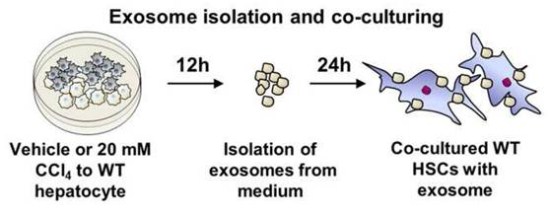Excessive! Exosomes and liver fibrosis are also mixed!
Scientists have studied the effects of IL-17 (interleukin-17) on liver disease, but the source of IL-17, especially liver damage and fibrosis caused by non-pathogens, is not known. Today we take a look at a story about exosomes and liver fibrosis described by researchers at KAIST in South Korea on Hepatology .
After liver injury, exosomes secreted by liver cells contain a variety of self-RNA (autoRNA). Recently, scientists have discovered that self-ncRNA is a catalyst for toll-like receptor 3 (TLR3). The researchers used TLR3 KO mice and wild-type mice to inject CCl 4 (carbon tetrachloride) to cause liver fibrosis, and found that IL-17A levels and fiber-related mediators in TLR3 KO mice decreased, indicating liver damage and IL-17A production, TLR3 related.
Liver fibrosis, how to cause IL-17A production?
The researchers stained cytokines and found that in acute liver injury, liver γδT cells (the T cells whose receptor is composed of γ and δ chains) are the main producers of IL-17A, and its cell number is in liver fibrosis. Significant reduction in TLR3 KO mice may be responsible for the reduction of IL-17A in early liver fibrosis.
So many IL-17A in γδT cells, where do they come from?
In general, IL-17A is mainly produced by CD4 + T helper. This inevitably makes everyone wonder how γδT cells produce IL-17A.
The researchers took the transfer of eGFP-derived γδT cells to the fibrotic liver and found that only 0.1% of the liver lymphocytes could transport γδT cells, and most of the rest were in close contact with activated HSC cells (hepatic stellate cells). It is suggested that HSC cells play a role in this process. The researchers then began to study it: knockdown of TLR3 in HSC cells, IL-17A, IL-1β, IL-12p40 and IL-23p19 decreased, indicating that TLR3 activation in HSC cells, even with liver damage and fibrosis The recruitment and activation of γδT cells is related!
What is the connection between HSC and γδT cells? Is it...
Yes, the researchers thought of exosomes (exo). The researchers first tested whether exo would affect the expression of the above related genes.

Hepatoma cells were treated with CCl 4 , and exo (hereinafter referred to as CCl 4 -exo) in cell culture medium was extracted after 12 h, and HSC cells were incubated for 24 h.

Dil marked exo, observed that many exo entered the HSC intracellular

CCl 4 -exo increases the expression of these genes in HSC cells, so that IL-1β and IL-23 can increase γδT cells and increase IL-17A production.
The researchers also found that TLR3 activates dormant HSC and increases RORγt expression, increasing IL-17A production in γδT cells; IL-17A + γδT cells in chimeric mice without TLR3 established by TLR3 KO bone marrow transplantation screening cut back.
Does expression of IL-17 require exo to activate TLR3 in HSC?

Hep3B and hES-Hep cells were stimulated with CCl-4, exo (ie CCl 4 -exo) was extracted and co-cultured with HSC cell line LX-2 or hTert for 24 h. qPCR results showed that CCl 4 -exo increased the IL- of both cells. 17A expression.

For knockdown of TLR3 or normal LX-2 cells, exo or poly I:C treatment (which activates TLR3) is performed, and qPCR is performed. Exo or poly I:C treatment increased IL-17A expression, while IL-17A decreased after knockdown of TLR3.

This study describes the early stages of liver fibrosis, in which congenital γδ T cells are the main source of IL-17A, which is reflected in the interaction of γδ T cells with HSC cells (TLR3 mediates IL-17A production by HSC cells). The researchers hypothesized that an unknown self-TLR3 ligand is produced after liver injury, and exo, exo, activates TLR3 in HSC cells, increases IL-17A in γδ T cells, and aggravates liver fibrosis.
Original: Seo W, et al . Exosome-Mediated Activation of Toll-Like Receptor 3 in Stellate Cells Stimulates Interleukin-17 Production by γδ T cells in Liver Fibrosis. Hepatology . 2016 May 14.
Related meeting recommendations
2017 4th non-coding RNA and epigenetic research experience exchange meeting
Meeting time: 2017.6.10 -6.11 Meeting place: Guangzhou Science City
Conference details: http://
It looks so nice and taste good!Lishida Mushroom Dark Soy Sauce is brewed from high-quality non-GMO soybeans,mushroom and other good ingredients in Chinese traditional process and packaged by advanced production and filling equipment.Dispencing with other condiment,it is perfect for stir-frying dishes,rice dishes and as marinate for meats,fish and vegetable dishes.Let's find more great recipes with it!
Mushroom Dark Soya Sauce,Mushroom Dark Soy Sauce,Mushroom Flavored Soy Sauce
KAIPING CITY LISHIDA FLAVOURING&FOOD CO.,LTD , https://www.lishidafood.com